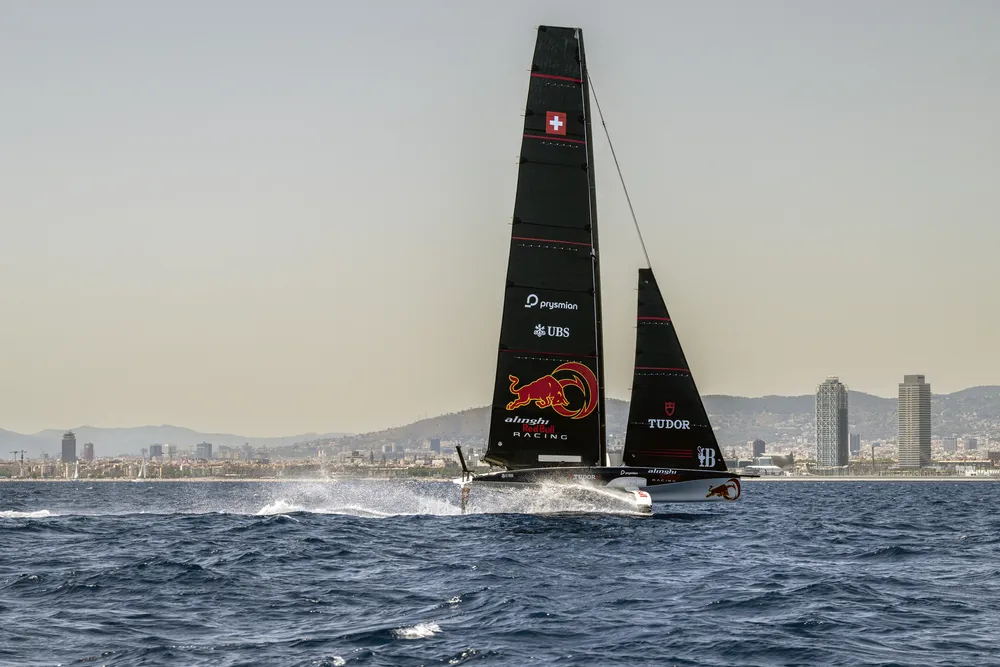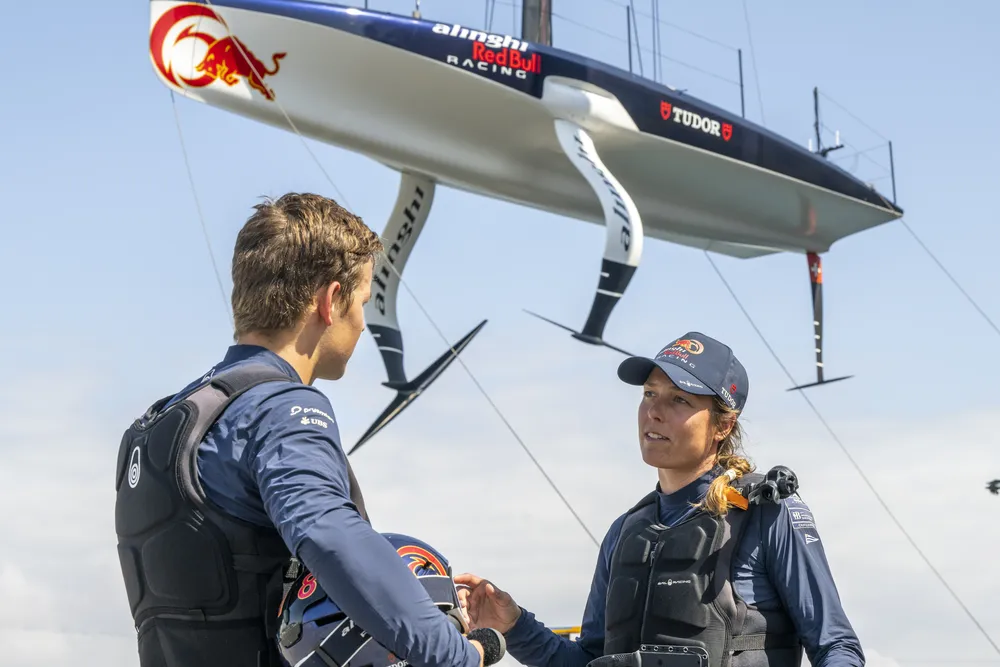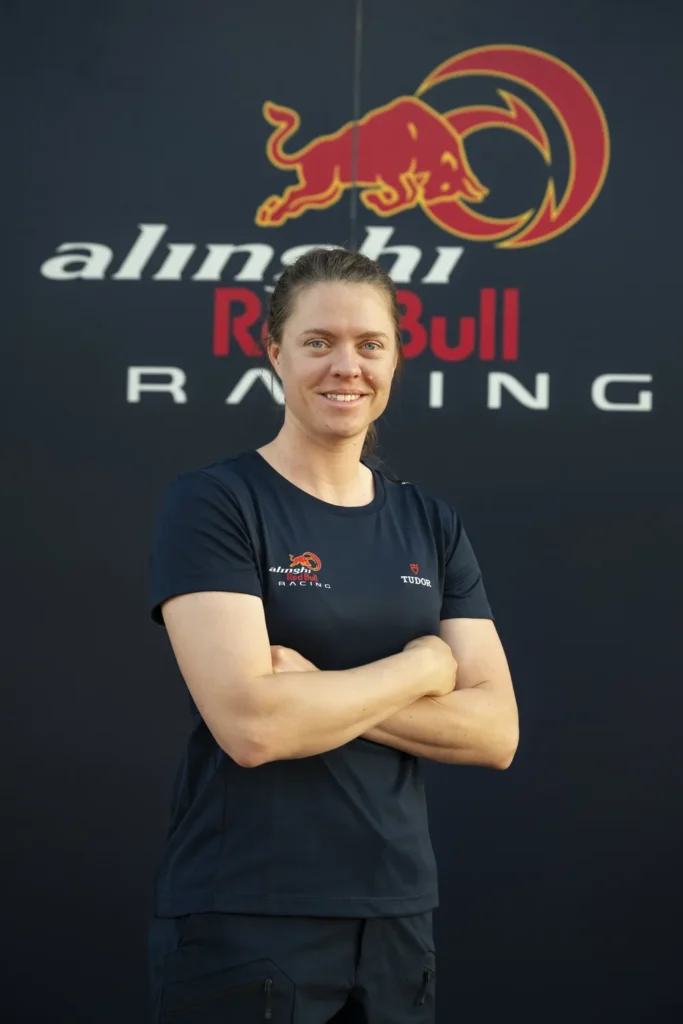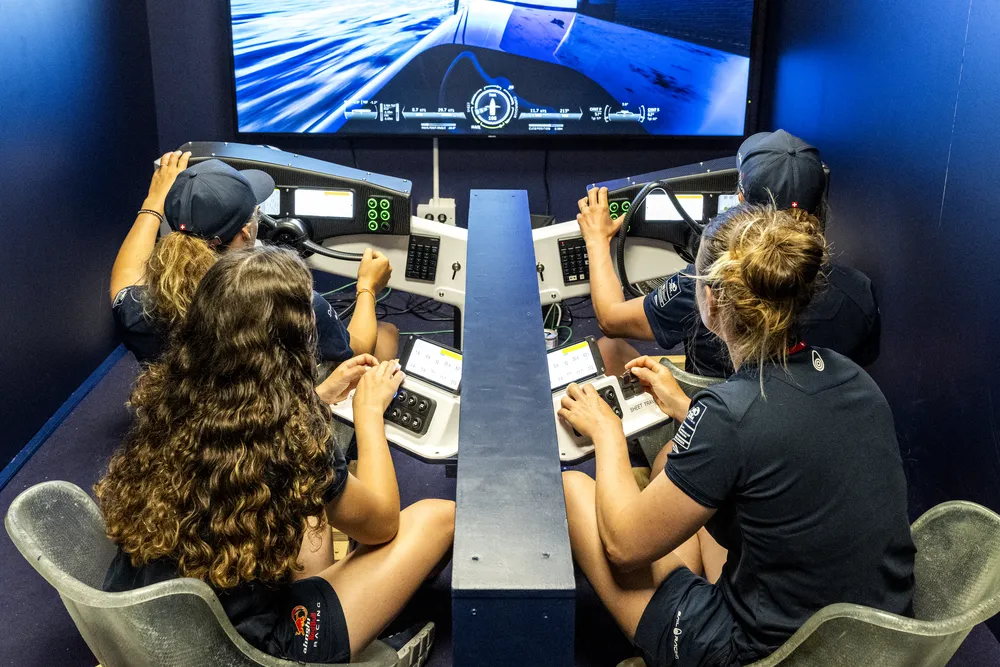The first Women’s America’s Cup will take place in Barcelona from October 5 to 13. An ideal opportunity to shed new light on the participation of women in the regatta.
Text: Quentin Mayerat
With a few exceptions, female sailors have long been excluded from the oldest sporting trophy of modern times. In Barcelona, they will finally get the chance to show off their skills and experience glorious moments. Although the format and the resources invested in the regatta reveal a glaring imbalance between the men’s and women’s events, the Women’s America’s Cup is seen by many as an important step towards greater gender equality in sailing. In spring 2023, Alinghi Red Bull Racing launched a new selection process in which six women and six young talents were chosen to fly the syndicate’s colors. But what do the female sailors themselves expect from their first America’s Cup? And what are their chances of winning?

Top-class field of participants
In the Women’s America’s Cup, twelve teams compete against each other in two groups of six: the teams from the Cup syndicates on the one hand, and the guest teams from Spain, the Netherlands, Australia, Canada, Sweden and Germany on the other. The top three teams in each group will reach the semi-finals, with the top two semi-finalists advancing to the final, where they will battle it out in a single match race. Depending on the results of each team, a total of two to four regatta days are on the program. Short and sweet, almost fast-paced. There is no room for mistakes. It looks like the Swiss women will start in the stronger group. However, not much is known about the level of the other AC40 crews at the moment. Coraline Jonet, Head of the Youth & Women Program at Alinghi Red Bull Racing, confirms the limited opportunities for comparison due to the rules: “Until the end of July, we were not allowed to sail more than 20 seconds on the same course as our competitors. We always had to maintain a minimum distance of 400 meters. And like the men, we were also forbidden to pass a buoy with a gap of less than 30 seconds.” The rules for the women are just as draconian as those for the men, but to make matters worse, the women’s teams – like the youth teams – do not take part in any preliminary rounds.
Knowledge transfer
Before the start of the regatta, the Swiss women’s and youth teams will only have trained together on the water for around forty days. An intensive program: In addition to the training sessions, they completed a crash course with their colleagues and the technical teams. “We were coached by Jason Waterhouse, a stroke of luck! He taught us the basics of AC40 sailing during our first outings in Jeddah last winter. That helped us to speed up the learning process and avoid making big mistakes,” reports Nathalie Brugger, the skipper of the Swiss team and two-time Olympic diploma winner (Beijing and Rio). Despite her vast experience, like most of her teammates she had to learn foiling from scratch. “Apart from Laurane Mettraux, who is taking part in the SailGP, none of us have any experience with boats going over 40 knots,” agrees Coraline Jonet.

The women’s and youth teams have to make the most of the available resources. According to Nathalie Brugger, this is achieved through various measures: “Despite the restrictions that make it impossible for us to train under optimal conditions, we took part in very useful workshops with the technicians and engineers. We also spent a lot of time on the simulator and with video analysis. The work on land is just as important as the work on the water.”
The AC40 is no ordinary boat. As on the AC75, the helmswomen do not change sides with every course change. There is a skipper and a trimmer on both the starboard and port sides. Communication is crucial here, as the sails block the view on leeward courses. “I first had to learn this type of sailing,” emphasizes Nathalie Brugger. “While I’m steering, I have to determine the altitude and the angle of attack of the foils. We define the values and the computer then regulates the flight.” The 25-year-old 49er FX specialist Alexandra Stalder got to grips with the AC40 better than expected: “The boat is easier to steer than I thought. In light winds, however, it’s not easy to keep it in flight. The pre-starts are also tricky, especially because of the boundaries and because we don’t know the strategies of the other teams. We are therefore working on the simulator with different configurations.”
Coraline Jonet, Matías Bühler and Pierre-Yves Jorand, the creative minds behind the Youth & Women program, have done everything they can with the limited resources available to ensure that their protégés are well prepared for the competition. Nathalie Brugger knows this too. “It’s clear to us that the Cup team has priority. All resources have gone into the project and that’s legitimate,” she affirms. “We will make the best possible use of the tools available to us and continue to learn until the day before the first regatta.”
A springboard for women?
The Swiss team is made up of talented youngsters with plenty of experience in Olympic boat classes. Anja von Allmen, Marie Mazuay and Maja Siegenthaler need not shy away from comparison with the competition. They all know that, despite their shortcomings, this competition can be a springboard for their future careers. Alexandra even speaks of the “biggest opportunity of her life” and Nathalie Brugger says: “A new chapter begins for me after the Olympics.”
Team boss Coraline Jonet assumes that the Women’s America’s Cup will have a generally positive effect on women’s sailing. “Muscle power doesn’t play a role on the AC40, we are on a par with the men,” she explains her assessment. Nevertheless, there is still a lot to do: “Women have much less experience with foiling than men. We need to catch up. This year’s America’s Cup premiere is a step in the right direction, but more initiatives like this are needed to ensure as many hours on the water as possible.” There are rumors that a regatta tour on the AC40 yachts is being planned, she reveals. This could help keep the momentum going and give more women the opportunity to sail boats at over 40 knots.
Alinghi Red Bull Racing is optimistic: “We are aware of the role of the events as a springboard,” asserts Coraline Jonet. Five of our current team members have taken part in the Youth America’s Cup.” All five are men! Let’s hope that the America’s Cup will also give women a career boost. At the moment, the number of female sailors with AC experience can be counted on one hand. This is not a glorious state of affairs for the oldest sporting event of the modern era, which has been promoting its innovations.



